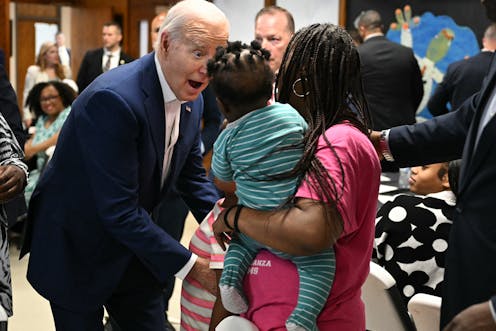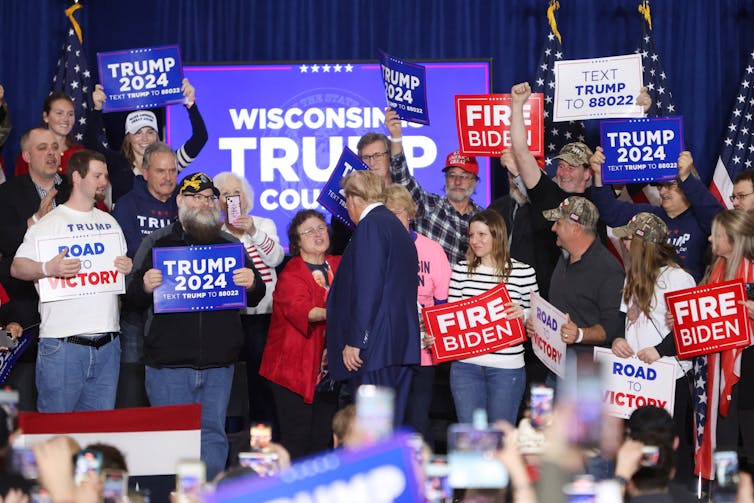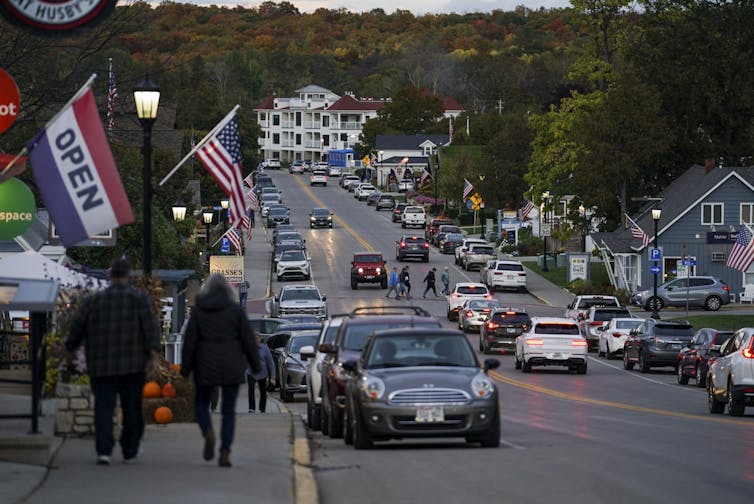Wisconsin is a key swing state this year – and has a history of being unpredictable
Wisconsin voters elected conservative and liberal politicians in almost equal numbers from 2008 to 2022 − in this election, issues such as abortion, the economy and immigration are key for voters.

Voters in Wisconsin – now considered a critical swing state ahead of the 2024 presidential election – may be among the most unpredictable in the nation.
Although former President Barack Obama carried the state in the 2008 election and again in 2012, Wisconsin voters stunned pollsters by voting for Donald Trump in 2016, marking the first time since 1984 that the state’s electoral votes went to a Republican. Then, in the 2020 election, the state’s voters chose a Democrat again – Joe Biden.
Wisconsin voters have also vacillated in their support for governors – selecting Republican Scott Walker in 2010 and 2014 with sizable margins, then voting for Democrat Tony Evers in 2018 and 2022.
Nonpartisan state Supreme Court elections have produced similar results, with a mix of conservative victories in 2017 and 2019, and liberal victories in 2018, 2020 and 2023.
Recent polling shows that the race between Trump and Biden is very close in Wisconsin. A win in Wisconsin could be a big step to winning the election for either Biden or Trump.
I am a scholar of Wisconsin history and politics. Overall, statewide elections for governor, senator and Supreme Court justice have resulted in conservative and liberal victories in almost equal numbers between 2008 and 2022. Understanding Wisconsin’s recent, complicated political history and demographics gives some important context on how it became a key swing state in this year’s election.

A history of Wisconsin’s voting
In the early 20th century, the Republican party dominated Wisconsin, winning every statewide election between 1894 and 1930 and controlling large majorities in the Legislature.
In the late 1940s, activists began rebuilding the moribund Democratic Party, which drew on two major areas of strength. The first was the industrial lakeshore regions of Milwaukee, Racine and Kenosha counties, where the Democratic prospects were bolstered by labor unions and the strong socialist tradition of the city of Milwaukee.
Democratic support for national civil rights laws and nondiscriminatory equal housing laws in the 1960s also made the state’s African Americans reliable Democratic voters.
The second major issue driving support for Democrats was Madison, the capital and home of the University of Wisconsin, which by the 1970s became known as one of the most liberal cities in the country.
After years of organizing, Wisconsin Democrats finally broke the Republican monopoly by electing William Proxmire as senator in 1957 – he was reelected multiple times and served until 1989 – and Gaylord Nelson as governor in 1958.
For the rest of the 20th century, Democrats and Republicans remained evenly matched. Although both parties had support from particular populations – Republicans were more popular in the suburbs, while Democrats held more sway in larger cities – both parties campaigned across the state. And rural voters could be swayed by Democratic candidates’ agricultural policies or by Republicans’ appeal to conservative social values.
A shift in Wisconsin politics
By the 1990s, though, Wisconsin’s political geography began to change. Declining factory jobs in the automotive, heavy machinery and farm equipment industries reduced the number of union members, sapping a major source of Democratic strength in the state.
At the same time, a shift toward corporate farming in Wisconsin – meaning large-scale agriculture production traditionally managed by private companies – reduced the overall number of small and medium-sized family farms. This created a rural state population not directly involved with agriculture and also diminished Democrats’ ability to appeal to nonurban voters.
Republicans capitalized on this trend by depicting Democrats as out-of-touch elitists who ignored those who did not live in urban centers such as Madison or Milwaukee.
After Obama’s 2008 election, Republicans rode a backlash against this perceived hostility toward rural and small-town white voters, electing Scott Walker governor in 2010. Republicans also secured a lopsided state legislative majority through partisan redistricting that favored their party.
The rural white voter
Trump’s 2016 campaign appealed to Wisconsin’s rural, overwhelmingly white voters, especially among those without a college degree.
Mitt Romney carried this Wisconsin demographic 52% to Obama’s 47% in 2012; Trump carried it 56% to 38%in 2016.
In 62 out of 72 counties, Wisconsin’s Republican vote increased between 2012 and 2016, and the sharpest increase was in rural counties. The “reddening” of these counties was instrumental to Trump’s victory, and this trend continued in 2020.
On the other hand, the most historically reliable Republican areas became noticeably less Republican. Republican turnout declined significantly in suburban Milwaukee counties, including Ozaukee, Washington and Waukesha. Clearly, suburban voters were more skeptical of Trump than rural voters.
Heading into the 2024 Biden-Trump rematch, I believe this rural-urban split will likely continue, and the election will certainly be close. Many suburban Republicans remain unenthused about a third Trump candidacy, turned off by his legal woes and the chaos of Jan. 6.
Economy a top issue for Wisconsinites
Biden faces his own headwinds.
The most important issue for Wisconsin voters is the economy. A March 2024 poll conducted by Emerson College and political publication The Hill revealed that economic issues, including the costs of health care and housing, were the most important concerns for nearly half of Wisconsin voters.
Concerns about inflation are a recurring theme, as campaign volunteers have heard when they go door to door.
The Biden campaign recognizes unease over the economy as a threat, and the president has made multiple visits to Wisconsin over the past few months promoting his infrastructure plans and the growth in manufacturing jobs in Wisconsin under his administration.
Abortion and immigration also matter to voters
If concerns over the economy boost Trump’s chances in the state, another potent issue provides a significant advantage for Biden.
Approximately 80% of surveyed Wisconsin voters identified abortion rights as “one of the most” or a “somewhat” important issue for them in May 2024.
Right now, abortion is legal in Wisconsin until 20 weeks of pregnancy, but there are lawsuits challenging this policy.
Even some Republicans are uneasy with the fact that the three U.S. Supreme Court justices that Trump appointed were instrumental in overturning Roe v. Wade in June 2022. Trump’s continual shifting on abortion has not reassured some local Republican leaders who are worried about a pro-abortion rights surge toward Biden.
Additionally, Republican voters, despite the state’s distance from the southern border, express concern about immigration. Although this issue may help motivate Republicans otherwise not enthusiastic about Trump to vote for him, it is unlikely to sway many undecided or independent voters.

A duel to save America
The immigration issue is balanced by some Democrats’ concerns about preserving democracy itself and not electing Trump.
Both Democrats and Republicans have used apocalyptic language urging Wisconsin voters to “save America,” but Democrats can point to the Jan. 6, 2021, riot and Trump’s ongoing legal problems rather than Republicans’ more abstract concern about border security.
In the recent Emerson College survey, 9.5% of Wisconsin respondents listed “threats to democracy” as the No. 1 issue for voters.
Pro-Palestinian encampments at Wisconsin universities, as well as the police response to the protests, might also undermine Biden’s support among younger, more liberal voters.
A Biden victory in Wisconsin would require a big turnout in Madison and Milwaukee. But the youth vote in Wisconsin – as well as elsewhere – may be diminished out of concerns over the Israel-Hamas conflict in the Gaza Strip, potentially costing Biden reelection. Strong turnout in rural counties, combined with continued anxiety over inflation, could very well make Wisconsin flip back to Trump.
Jonathan J. Kasparek does not work for, consult, own shares in or receive funding from any company or organization that would benefit from this article, and has disclosed no relevant affiliations beyond their academic appointment.
Read These Next
Chile elects most right-wing leader since Pinochet – in line with regional drift, domestic tendency
José Antonio Kast, who has run for the presidency several times, successfully seized on widespread…
Epstein’s victims deserve more attention than his ‘client list’
Powerful men connected to Jeffrey Epstein are named, dissected and speculated about. The survivors,…
The ‘one chatbot per child’ model for AI in classrooms conflicts with what research shows: Learning
AI tutors are often held up as an ideal, but prioritizing individualized teaching can detract from the…






